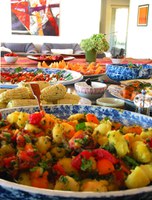Prairie Fare: Safe Food Preservation Advice Comes Early This Year
(Click the image below to view a high-resolution image that can be downloaded)
By Julie Garden-Robinson, Food and Nutrition Specialist
NDSU Extension Service
We have reached the time of year when church potlucks are plentiful and garages are cleared out to become open-air dining rooms for graduation parties. No one wants a special event with bountiful food and numerous guests to become a recipe for disaster.
Unfortunately, food prepared or stored unsafely can cause illness or even death. You may have read about a recent potluck held at a church in Ohio where numerous people were stricken and one person died of botulism.
According to recent reports, the food linked to the fatal outbreak was potato salad.
When potato salad and foodborne illness are mentioned in the same sentence, most people think mayonnaise was the culprit.
Commercial mayonnaise is a safe food that is acidic enough to deter the growth of many types of bacteria. Usually unwashed hands or another ingredient is the issue.
In the Ohio incident, home-canned potatoes have been implicated as the cause of the botulism outbreak. The potatoes most likely were not pressured canned following current research-tested guidance. All low-acid vegetables must be pressure canned to be safe.
This food processing technique increases the temperature to a level (240 F) that kills bacteria and their spores (inactive forms of bacteria).
Usually my columns about home canning appear during the summer months to coincide with harvesting gardens. However, sometimes home-canned goods from last summer are served as “special treats” during potlucks and family celebrations, as may have happened in the fatal incident.
The botulism toxin is colorless, odorless and tasteless. You might not experience symptoms until two days after you eat the food. A tiny amount can make you ill. The symptoms of botulism include weakness, dizziness, double vision, difficulty swallowing and later, difficulty breathing. Without prompt treatment, botulism may be fatal.
Fortunately, botulism cases are fairly rare. About 30 botulism cases are reported yearly in the U.S. and most of those cases are associated with food canned improperly at home.
How does the toxin get in the jar of food? The spores are all around us. They are found in soils, bottom of lakes and in the intestinal tracts of animals and fish. The spores usually are harmless. However, when vegetables are cooked and placed in a sealed canning jar, the spores can “come to life” and, at that point, can produce the neurotoxin (poison that affects the nervous system).
Low-acid foods are linked with botulism because the toxin does not form in acidic foods. This is why you can process green bean pickles in a water-bath canner safely, but you can’t process plain green beans in a water-bath canner. The pickles are acidic.
Low-acid foods include vegetables, meats and most mixtures of foods. Tomatoes are a special case. All tomatoes canned at home must have added lemon juice or citric acid to be considered safe. See http://www.ag.ndsu.edu/food for current recommendations and safe equipment to use when home-preserving foods (click on Food Preservation).
Personally, I’ve never been considered a “finicky eater.” However, I am quite picky when it comes to home-canned food. The risk of losing my ability to breathe is a real deterrent to me.
Be sure the food that you canned or the home-canned food you taste was made and processed using the most current canning techniques from the National Center for Home Food Preservation, from universities or from reputable food processing companies such as Ball.
If someone offers you some home-canned food, ask some questions. Did the person use a research-tested recipe or did the person “invent” the recipe? If the person is a food scientist with a commercial grade pH meter and extensive experience as a food processing authority, I probably would take a bite. I would watch the food scientist taste the food first, though, just to be sure. I also might wait a couple days to see if the food scientist was still healthy.
However, if the person found the recipe on a website with no credible backing, I would steer clear. Although you might not win a popularity contest by questioning the safety of the food, your health is more important, right?
When made with safe ingredients, potato salad can be flavorful and colorful, and it makes a delicious addition to a potluck buffet. Be sure to keep it cold by nesting bowls of potato salad in bowls of ice on your buffet line. Here is a recipe posted on the U.S. Department of Agriculture’s website (http://www.watscooking.fns.usda.gov).
Herbed Potato Salad
1 1/2 pounds red potatoes (quartered or cut into small chunks)
1/2 c. Italian dressing, light
1/2 Tbsp. spicy brown mustard
1 Tbsp. chopped, fresh parsley (or substitute 1 tsp. dried)
3/4 tsp. garlic salt
1/4 tsp. black pepper
1/2 c. green bell pepper, chopped
1/2 c. red bell pepper, chopped
1/2 c. green onion, sliced
Cook potatoes in boiling water over high heat until tender. Drain well and let cool. Place potatoes in a medium bowl and set aside. In a small bowl, combine the dressing, mustard, parsley, salt and pepper. Pour mixture over potatoes and toss well. Carefully stir in bell peppers and green onions. Cover and chill until ready to serve.
Makes six servings. Each 1/2-cup serving has 120 calories, 2 grams (g) of fat, 3 g of protein, 22 g of carbohydrate, 3 g of fiber and 350 milligrams of sodium.
(Julie Garden-Robinson, Ph.D., R.D., L.R.D., is a North Dakota State University Extension Service food and nutrition specialist and professor in the Department of Health, Nutrition and Exercise Sciences.)
NDSU Agriculture Communication – April 30, 2015
| Source: | Julie Garden-Robinson, (701) 231-7187, julie.garden-robinson@ndsu.edu |
|---|---|
| Editor: | Rich Mattern, (701) 231-6136, richard.mattern@ndsu.edu |


